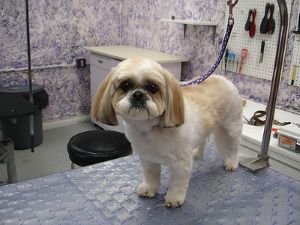
If you’ve never heard about your dog’s anal glands, you might have already smelled them.
Coming with a malodorous fishy smell, anal gland problems are hard to ignore—but what is their purpose?
And what should you do if something goes wrong with them?
Anal glands are the two small oval glands located on either side of your dog’s anus.
They give off pheromones that can tell other dogs information about your dog, and the glands also help to keep your dog’s stool healthy.
However, there are things that can go wrong with the anal glands and sometimes they need to be expressed, treated, or checked out by a veterinarian.
What happens when a dog has their glands expressed?
If your dog needs his or her gland expressed, you can choose to take them to the vet to have the procedure done or perform it yourself at home.
Anal gland expression is very simple to do and doesn’t require any special tools or skills.
Though, if you have never done it yourself before, sometimes it is easiest to have a qualified veterinarian show you how to express the glands at home.
When a dog has their gland expressed, liquid will be released from the anus in slow, gradual drips.
This liquid often smells like fish and has a strong odor.
The consistency of the liquid can differ, but it generally can look anything like a clear consistency to a grainy brown substance.
The important thing to look for, during anal gland expression, is blood, pus, or a pasty consistency.
If any of these things occur at home, it’s time to consult your veterinarian.
How can I tell if my dog needs their glands expressed?
When there is a problem with your dog’s anal glands, they will most likely let you know it.
Many dogs exhibit specific symptoms that you can watch out for.
Your dog might scoot across your living room carpet repeatedly, even after being told to stop.
They might also lick at their bottom excessively and show that they are uncomfortable sitting down.
Your dog might also need their glands expressed if you sometimes smell a fishy odor on furniture, in the car, or on your carpets.
This odor comes from the occasional release of the anal glands when they should not be released, and it’s a good sign that your dog’s anal glands are full.
Why do some dogs need their anal glands expressed?
While most dogs release their anal glands naturally during defecation, about twelve percent of dogs don’t—meaning that the glands need to be expressed manually.
While we’re not really sure what exactly causes this, some contributing factors can be weight, age, diet, exercise, and sometimes some inclination to small breeds.
Even if your dog is perfectly healthy and has not had previous issues with their anal glands, the glands can occasionally get clogged, or your dog can produce too much fluid.
The most common reason why dogs need their anal glands expressed is due to swelling or inflammation in the anus.
This swelling can close the area that the dog has to defecate, not allowing outflow of the liquid in the anal glands.
Over time, this liquid will add up and cause pressure and discomfort to your dog.
Is it normal for a dog to be in pain after having their glands expressed?
If your dog appears to be in pain after having their anal glands expressed, something might be wrong.
Anal gland expression is a natural process that most dogs can perform on their own. If your dog has redness or swelling in the anal area, it’s important to contact a vet.
Dogs that need to receive anal gland expression should be monitored, after treatment, to be sure that they are acting normal, happy, and free from pain.
Why might a dog be in pain?
After an anal gland expression, dogs can sometimes show signs of discomfort. One of the main reasons for discomfort after anal gland expression is that the anal glands were not fully emptied.
Unfortunately, if a dog’s anus is swollen, it can be hard to tell if all of the liquid was released.
If the dog had a severe anal gland impaction, they might need to have the liquid expressed again a few days after the first expression.
Another reason your dog might be in pain after a gland expression are anal abscesses.
An abscess is a painful infection happening inside of the anal gland.
If an abscess was the reason for the gland expression, your dog might still be dealing with the aftermath of an infection after your trip to the vet.
While redness and swelling should decrease, if your dog continues to have a sore bum, it might be worth another call into the vet’s office.
What other side effects might a dog suffer after having their glands expressed?
After having their anal glands expressed, a dog might suffer other side effects as well.
Sometimes the anal sacs can become sore after expression if the vet needs to use a special softening injection.
This injection helps the liquid in the anal sacs to be released if it becomes hard, but the injection site can be uncomfortable afterward, causing some butt scooting and excessive licking, even when the liquid has been released.
If your dog has a lot of butt floof, they might also have had to have their bum shaved before their procedure.
While this isn’t uncommon, the razor burn in this area can be extremely uncomfortable.
Many dogs will have redness or soreness in the area for a few days, until the hair starts to grow back.
When the hair grows back, it can also cause increased itchiness.
What sorts of dogs or breeds of dogs are more likely to need their glands expressed?
While dogs of any age and sex can be affected, some breeds are more predisposed to anal gland problems than others.
It seems that small breed dogs are more likely to have problems with their anal glands, though no one really knows why.
A few of the breeds that are typically inclined to these problems are Toy and Miniature Poodles, Chihuahuas, and Lhasa Apsos.
Similar to these small breeds, some medium breeds can have issues as well.
Cocker Spaniels and Basset Hounds are known to have regular anal gland difficulties. Beagles are known to be predisposed to anal gland expression difficulties, as well.
Some dog breeds can also be inclined toward an anal gland disease called perineal fistula.
Breeds like German Shepherds, Golden Retrievers, and Cocker Spaniels can suffer with this disease, which causes chronic foul-smelling wounds near their anal tissues.
This condition means that the dog needs to be treated repeatedly for their anal glands and will often need veterinarian intervention throughout their life to ensure that the dog remains healthy and comfortable.
Why do dogs have anal glands?
There are many reasons why dogs might have evolved to have anal glands.
One of the more commonly known reasons for anal glands is for dogs to mark their territory.
When the anal glands are released, it releases a scent, or pheromones, to other dogs to give them information.
When dogs catch each other’s scent, or inevitably start butt circling with another dog before greeting, it gives them unique information about each other’s age, sex, and health.
Dogs might also have anal glands to help them defecate.
One theory to this strange evolutionary process is that the anal glands lubricate the anus to help hard stool pass without intervention.
Can I soothe my dog’s glands?
If your dog is regularly struggling with anal gland problems and needs expressions every few weeks, there are a few things you can do to help soothe the area and try to prolong expressions.
One great option is to increase the amount of fiber your dog is getting in their diet.
An easy way to do this is to buy one hundred percent, canned pumpkin from the grocery store and begin adding a few tablespoons to your dog’s meals.
Pumpkin is a fantastic source of fiber for dogs, and it can help your dog’s stool to become healthier, which in turn causes the anal gland liquid to release on its own during defecation.
Another option to help soothe your dog’s anal glands is to hold a warm compress to the area.
Some vets believe that holding a warm washcloth up to the glands can help them express on their own, which can lengthen time between expressions.
Hold the washcloth up to your dog for five to ten minutes per day, twice a day.
Adding Epsom salt or witch hazel to the washcloth can also help relieve discomfort in the area.
While a more long-term solution, decreasing your dog’s weight and increasing their amount of exercise is also beneficial to soothing your dog’s anal glands.
Dog breeds that aren’t predisposed to anal gland problems can greatly benefit from increased health initiatives, which might help lessen their anal gland problems over time.
Closing Thoughts:
While few topics come across as strangely as talking about your dog’s anal glands, it’s important for pet owners to be aware of some of the signs and symptoms that can come with anal gland problems, and more importantly, the reasons that cause it.
If your dog is struggling with repeated anal gland problems, it might be time to consult a vet to determine the cause and how to treat the problem effectively.






